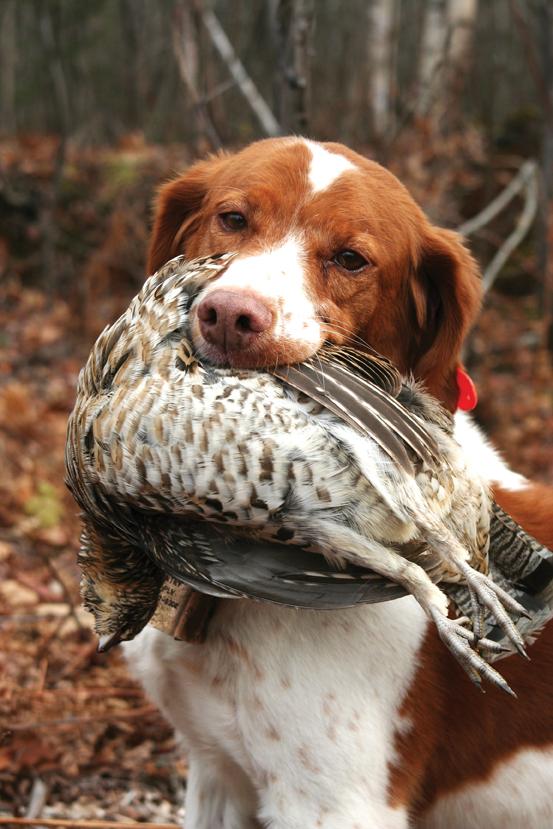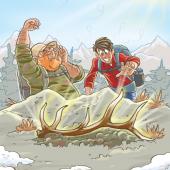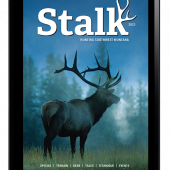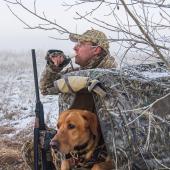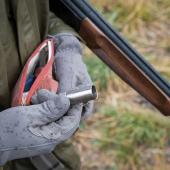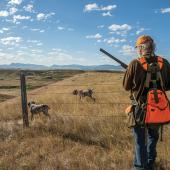All About Huns
I’d just finished filling the tank in my pickup when I heard the unmistakable chirp of a Hungarian Partridge, technically known as the gray partridge. It sounded like the rusty squeak of a gate hinge. But there weren’t supposed to be Huns there—I was in the concrete bay of a busy gas station, which itself sat in a busy intersection. Asphalt radiated out from the place like spokes on a wheel. Somewhere out there in all that paved former prairie was a Hun, lonely and looking for a friend.
If there’s anything characteristic about these ubiquitous Montana game birds, it’s that they show up, often as not, precisely where you don’t expect to see them. I’ve found coveys at 6,500 feet in the Absarokas and blithely flying over the Ford dealership on N. 19th. About the only time I can’t find Huns is when I’m specifically looking for them, with a shotgun in the crook of my arm and a pair of bird dogs quartering in front of me.
Identification
In the hand, Huns are easy to identify, though on the win they’re easy to confuse with chukars and sometimes sharp-tailed grouse. Handsome rusty-red face patches and tails are nearly identical on both males and females. Males have a slightly larger face patch than females and rusty-red shading on their wing shoulders. The distinct horseshoe-shaped red crescent on the Hun’s breast is more common on males, but not exclusive to them, as many hunters believe. A better way to confirm sex is to check the feathers on the shoulders. A female has dark brown horizontal bars, while a male’s are rust-colored.
Range
Though Huns are not native—they were imported here from Europe in the early 1900s—they thrive in much of Montana. Prime habitat in Montana is from the Rockies east and from MT Hwy. 200 north, as well as in many mountain valleys in the western third of the state.
Huns are known as an “eruptive”species, which means there can be a lot one year and not many the next. (A cold, wet late June is deadly on chicks.) When populations are up, you can find Huns almost anywhere. When numbers are down, coveys retreat to prime habitat: agricultural land, ideally a grass and sagebrush mix interspersed with fields of wheat or barley. Lightly grazed rangeland can also hold good numbers of birds.
When the birds live in wheat country, their fall and winter diets may be almost exclusively wheat kernels and sprouts of volunteer wheat. In rangeland, they’ll dine on grass and weed seeds, as well as the occasional grasshopper or other bug. Like most upland bird chicks, young Huns need to eat abundant insects to grow.
Courtship and Nesting
By mid-February, Huns begin pairing up. The pairs nest in grasslands, sometimes near the borders of wheat fields, where the female lays a clutch of 16 to 18 eggs. The chicks—tiny yellow creatures no bigger than your thumb—are up and running by the end of June or early July. Huns are so secretive I don’t start seeing family groups until August. By September, a typical covey will consist of the parents and chicks, with maybe a stray male or two they’ve picked up along the way. Covey size is typically around a dozen birds.
Hunting
Huns are superb game birds. They hold well for a pointing dog, flush hard, and fly fast. But they aren’t popular with many upland hunters, likely because the birds can be hard to find and often live in broken, hilly country where the walking is difficult.
Dave Carty is an avid bird hunter and freelance writer living in Bozeman. This story originally appeared in Montana Outdoors.


